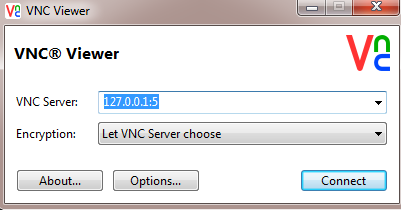

- #CREATE SSH TUNNEL VNC VIEWER KVM VM CONSOLE HOW TO#
- #CREATE SSH TUNNEL VNC VIEWER KVM VM CONSOLE WINDOWS#
Tried gnvcviewer, both directly and through the tunnel. Lsof (on the KVM host) shows that 5903 is LISTENing. and connecting to the same client VM works fine over port 5903. $ ssh -L 5903:localhost:5903 -N -f -l thefu romulusĬhannel_setup_fwd_listener_tcpip: cannot listen to port: 5903

The OP's settings appear to be correct, so I doubt that is the issue. Tried to connect to a KVM host (14.04 server) and different clients following: Perhaps I have my wires crossed? Appears that way on 3rd look. I am dubious about my posted ssh tunnelling cmd (definitely not my forte) but I don't see where i've got my wires crossed?
#CREATE SSH TUNNEL VNC VIEWER KVM VM CONSOLE WINDOWS#
Hey Fu, not following what I've misunderstood.OP is trying to tunnel port 5900 from Windows client to Ubuntu host as his Windows guest is configured to only allow VNC connections from the localhost and whilst the post doesn't say which vnc client it does mention the use of a vnc client. Trying to connect with ssh on 5900 won't work. Respect to KillerKelvUK, but I think he misread the issue (we all do that sometimes, especially me). Always, always, always, use ssh-keys ASAP and disable password-based authentication for all remote (non-console) access. Using passwords 10 minutes after a new server is installed is a complete failure in my mind. That means ssh-keys work too, so connections don't use passwords. It is 2-3x faster than VNC and uses ssh-tunnels by default. x2go is the best, F/LOSS remote desktop that I know. I mostly use ssh to manage servers, but run 1 remote desktop to my primary "desktop" system, which runs headless inside a KVM VM. You can use putty (ssh), provided you installed and configured the ssh-server package. Console access is generally crap and using ssh or some other remote desktop tool post-install works great.
#CREATE SSH TUNNEL VNC VIEWER KVM VM CONSOLE HOW TO#
I don't use Windows, so don't know how to make it work from that platform, but on Linux clients, you can install virt-manager on the client machine and everything becomes double-click this-that for installations and remote access.

I've never used virt-install and I started with Linux virtualization in 2008. The output of the guestubuntu.xml file is:Īny guidance on where I am going wrong would be greatly appreciated. When I try to connect from a Windows machine using a VNC viewer I receive a message that the "Connection was refused by the host computer". Sudo virsh dumpxml guestubuntu | grep vnc Once the machine was created I used the command: disk path=/var/lib/libvirt/images/guesutbuntu.img,size=10,bus=virtio I have created a kvm virtual machine using the guide at as a base. I am running a headless server running Ubuntu 16.04.1 which is accessed through Putty and Webmin. I am trying to experiment with virtualization but have hit a stumbling block at pretty much the first hurdle.


 0 kommentar(er)
0 kommentar(er)
